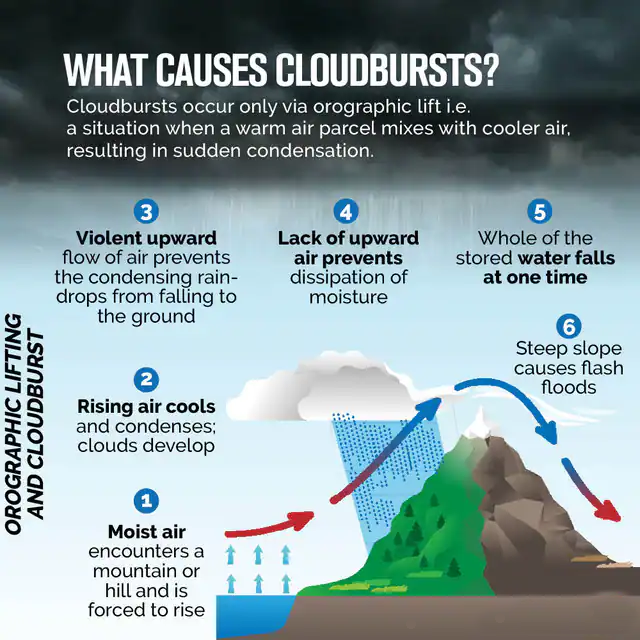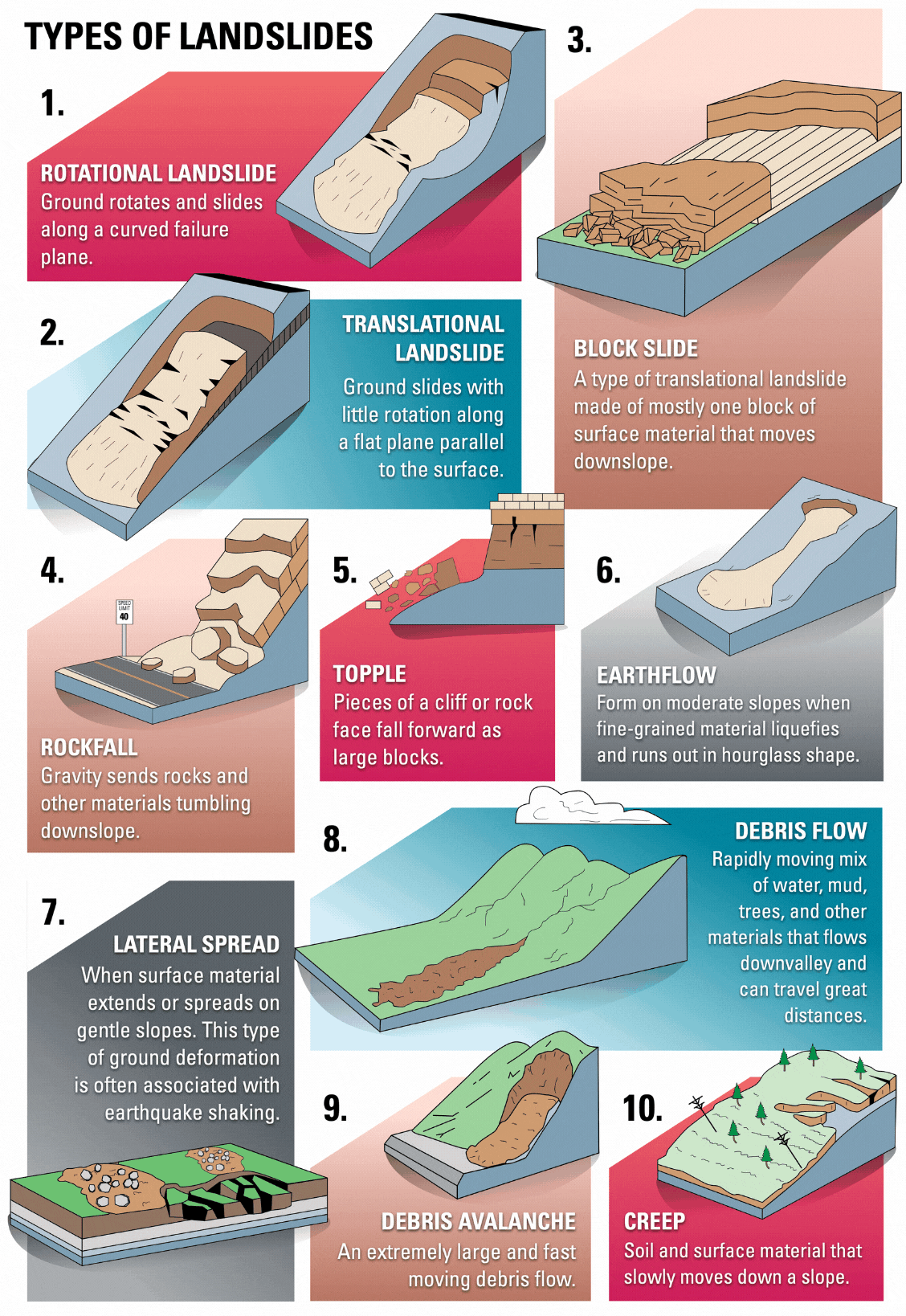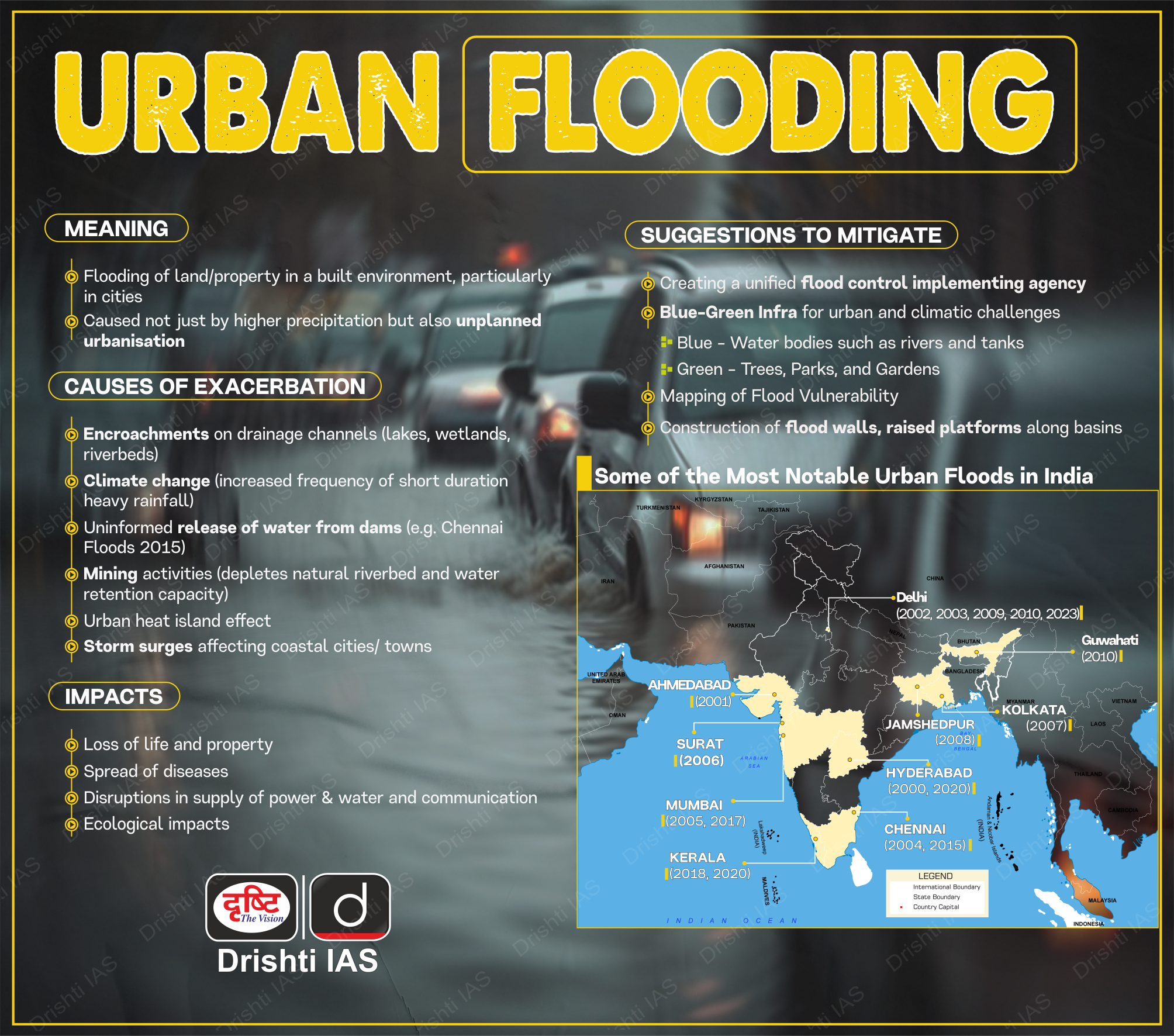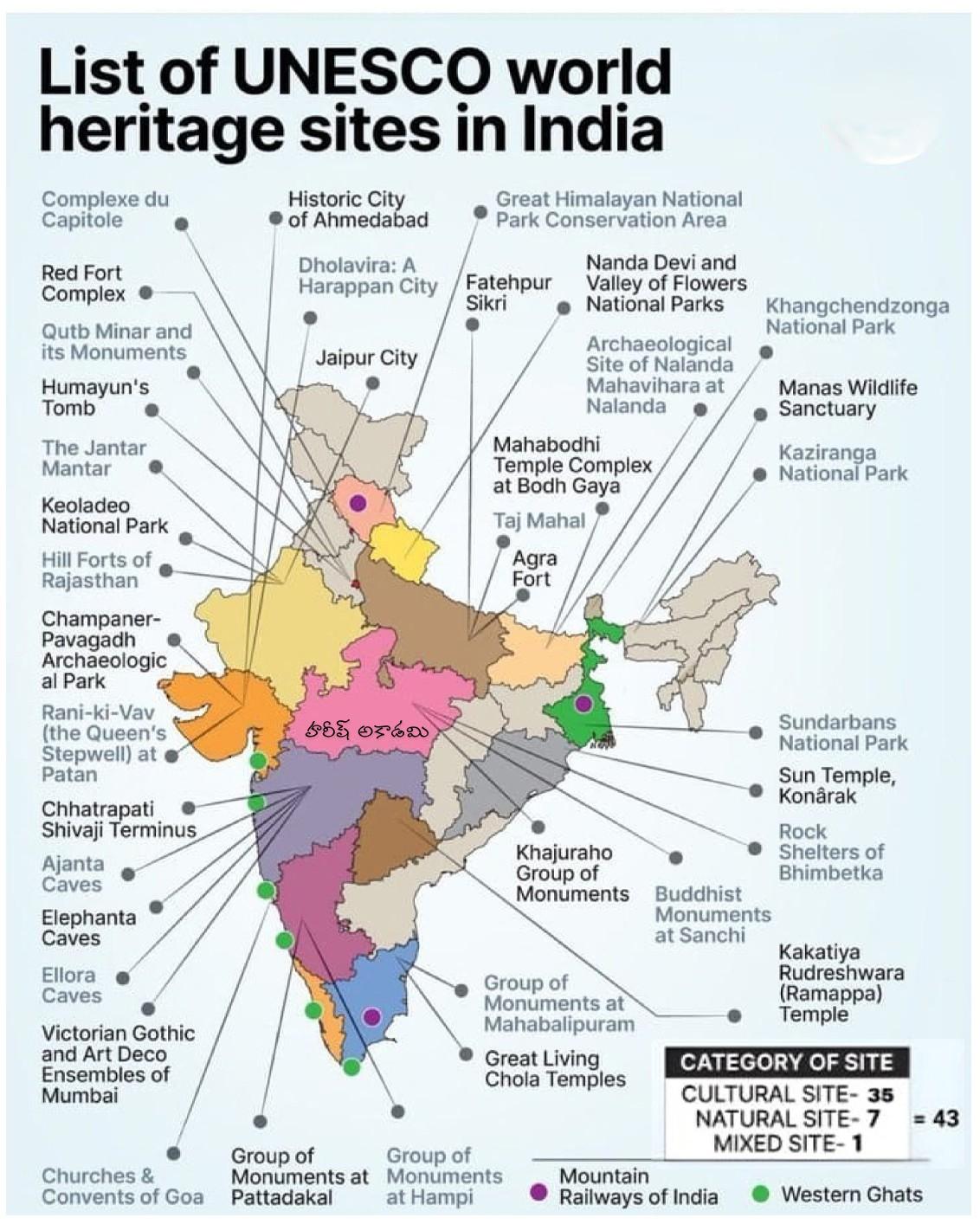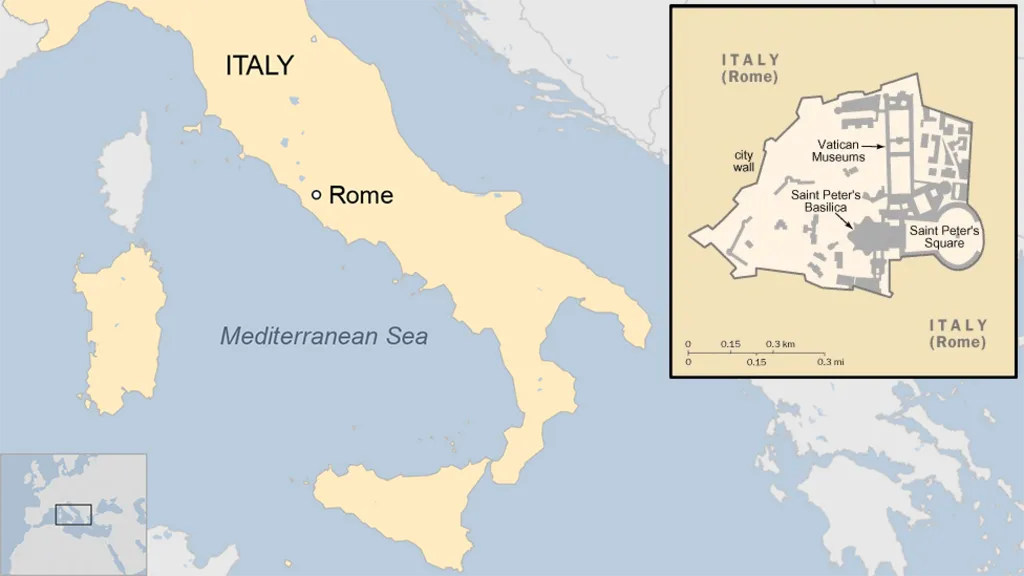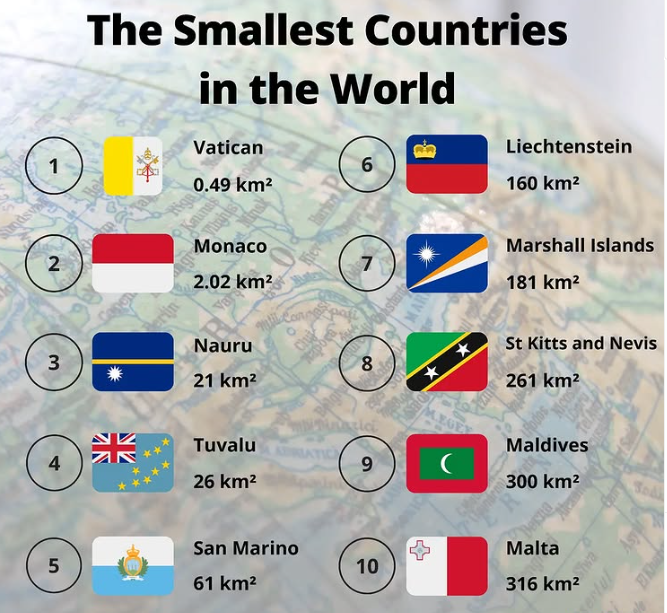Perovskite Solar Cells and India’s Solar Energy Growth
For Prelims: Solar energy, Rooftop Solar Programme, PM Surya Ghar Muft Bijli Yojana, Production Linked Incentive, International Solar Alliance
For Mains: Challenges for Solar Energy Adoption in India, Government Initiatives in Promoting Renewable Energy
Why in News?
A Nature study unveils a sustainable, water-based method for recycling Perovskite solar cells (PSCs), enhancing solar energy efficiency and supporting India’s push for greener energy.
What are Perovskite Solar Cells?
- About: A PSC is a type of thin-film solar cell that uses perovskite material as the light-absorbing active layer to absorb sunlight and generate electricity through the photovoltaic effect, offering high efficiency and low production costs.
- Perovskite Material: It refers to any compound that shares the same crystal structure as the mineral perovskite (CaTiO₃).
- In solar technology, it typically denotes metal-halide perovskites, which are hybrid organic-inorganic materials composed of a metal cation (like lead), a halide anion (like iodide), and an organic molecule (like methylammonium).
- These materials are known for their excellent light absorption, charge transport properties, and tunability, making them ideal for photovoltaic and optoelectronic applications.
- Key Concerns: PSCs contain toxic lead, posing significant environmental risks during recycling.
- Traditionally, recycling these cells involved harmful organic solvents like dimethylformamide, making the process even more hazardous.
- Green Recycling of Perovskite Cells (Nature Study): The study introduced a water-based method to recycle PSCs, eliminating the need for toxic solvents like dimethylformamide.
- The process uses sodium acetate to extract lead safely, while sodium iodide and hypophosphorous acid help regenerate perovskite crystals.
- Other layers are recovered using ethanol and ethyl acetate.
- This method recovers 99% of materials and maintains efficiency over five cycles, promoting a circular economy and reducing environmental impact.
- The process uses sodium acetate to extract lead safely, while sodium iodide and hypophosphorous acid help regenerate perovskite crystals.
What is India’s Current Solar Capacity?
- Solar Capacity: As of April 2025, the total installed solar capacity stands at 105.65 GW.
- This includes 81.01 GW from ground-mounted installations, 17.02 GW from rooftop solar, 2.87 GW from solar components of hybrid projects, and 4.74 GW from off-grid systems.
- Solar energy accounted for 47% of India's total installed renewable energy capacity, driving the nation's renewable energy growth.
- India's solar module production capacity grew from 2 GW in 2014 to 60 GW in 2024, establishing the country as a global leader. It aims to reach 100 GW by 2030.
- India’s Key Solar Initiatives: Rooftop Solar Programme is supported by initiatives like SUPRABHA (Sustainable Partnership for RTS Acceleration in Bharat) and SRISTI (Sustainable Rooftop Implementation for Solar Transfiguration of India), aimed at accelerating RTS adoption, It saw a 53% increase in 2024 with 4.59 GW of new installations.
- PM Surya Ghar Muft Bijli Yojana (PMSGMBY), the world’s largest domestic rooftop solar initiative, has reached a milestone of 10 lakh solar-powered homes as of 2025.
- The scheme offers free electricity to households by installing subsidized rooftop solar panels.
- The "Model Solar Village" initiative under PMSGMBY aims to establish one solar-powered village per district, promoting energy self-reliance.
- Pradhan Mantri Kisan Urja Suraksha evam Utthaan Mahabhiyan supports farmers with subsidies for solar pumps and grid-connected plants to promote clean energy in agriculture. By 2024, 6.1 lakh pumps were installed, 35 lakh solarized, benefiting over 4 lakh farmers.
- PM Surya Ghar Muft Bijli Yojana (PMSGMBY), the world’s largest domestic rooftop solar initiative, has reached a milestone of 10 lakh solar-powered homes as of 2025.
- Leading States: Rajasthan, Gujarat, and Tamil Nadu led the way, contributing 71% of India's total utility-scale solar installations.
What are the Major Challenges Facing the Solar Industry in India?
- Land Acquisition Conflicts: Utility-scale solar plants require ~5 acres per MW. In a country where agriculture is the mainstay, acquiring land for solar often leads to displacement, protest (e.g., Dholera Park), and compromises on food security.
- Rooftop solar requires shadow-free space (~300 sq. ft for 3kW), which is not available in many urban homes or apartment complexes.
- Due to land acquisition delays and related implementation hurdles, the target of 40 GW rooftop solar capacity by 2022, under the 100 GW solar goal for 2030, was missed, leading to an extension of the deadline to 2026.
- Lack of awareness and misconceptions about cost, maintenance, and installation hinder adoption.
- Infrastructure Deficit: India’s existing grid infrastructure, primarily designed for centralized thermal power, is ill-equipped to handle the intermittent and decentralised nature of solar energy.
- Transmission and distribution losses, though improved (from 23.7% in FY16 to 15.37% in FY23), still exceed the global average, posing integration hurdles.
- Investment Constraints: Upfront installation costs, ranging from Rs 2.2 lakh to Rs 3.5 lakh for a 3–5 kW rooftop solar system, remain a significant deterrent despite government subsidies.
- Solar projects require substantial capital investment, which poses a barrier for small players.
- Additionally, credit risk in loan disbursement and recovery from low-income households continues to concern financiers.
- Domestic Manufacturing Gaps: India heavily depends on imported solar modules and components, primarily from China, increasing vulnerability to supply chain disruptions.
- In 2023-24, India imported USD 7 billion worth of solar equipment, with China supplying 62.6%.
- Despite policies like the Production Linked Incentive (PLI) scheme, the growth of indigenous solar manufacturing is slow.
- Environmental and Social Impacts: Large solar parks, like Bhadla (Rajasthan), threaten biodiversity, while India is set to generate 34,600 tonnes of solar waste by 2030. The lack of a recycling policy exacerbates the environmental challenge.
- Limited Battery Storage Capacity: Battery storage technologies are expensive and underdeveloped in India, making it hard to ensure 24x7 solar availability.
- India has only 20 MWh of battery storage capacity, versus a projected 74 GW requirement by 2032.
How Can India Sustain and Accelerate Its Solar Energy Growth?
- Optimizing Land Use: With large-scale solar projects requiring significant land, integrating solar installations with agricultural activities (agrivoltaics) can optimize land use, ensuring food security while generating clean energy.
- Deploying solar panels on water bodies ( as seen in Kayamkulam floating solar project, Kerala and 100 MW Ramagundam Floating Solar Plant (Telangana)) can mitigate land acquisition challenges and reduce water evaporation, contributing to water conservation.
- Grid Modernization and Energy Storage: Under the National Programme on Advanced Chemistry Cell (ACC) Battery Storage there is a need to promotes scalable, cost-effective storage solutions to address solar intermittency.
- Integrate AI-enabled grid development with demand forecasting and real-time monitoring to improve load management.
- DISCOM Reforms: Revamping the financial health of Distribution Companies (DISCOMs) is essential to ensure timely payments to solar power producers, thereby fostering investor confidence.
- Circular Economy for Solar Waste: India should implement a national solar panel recycling policy in line with the E-waste Management Rules of 2022.
- This policy should incentivize the private sector to develop sustainable methods for managing solar waste, reducing environmental hazards, and fostering a circular economy for solar panel components.
- Enhancing Domestic Manufacturing: Although PLI schemes have bolstered module production, it is crucial to focus on upstream segments such as polysilicon, ingots, and wafers to build a resilient solar supply chain.
- International Collaboration: Leveraging platforms like the International Solar Alliance (ISA) can facilitate technology transfer, capacity building, and access to international funding, propelling India's solar ambitions.
Conclusion
India’s solar energy future depends on an integrated approach that tackles technical, economic, environmental, and governance challenges. By aligning with Sustainable Development Goal (SDG) 7, which focuses on ensuring access to affordable, reliable, sustainable, and modern energy for all, India can achieve its domestic energy targets and become a global leader in the clean energy transition, reflecting its climate commitments and sustainable development vision.
|
Drishti Mains Question: Discuss the major challenges facing the solar energy industry in India and propose measures to overcome them. |
UPSC Civil Services Examination Previous Year Question (PYQ)
Prelims
Q. Consider the following statements: (2016)
- The International Solar Alliance was launched at the United Nations Climate Change Conference in 2015.
- The Alliance includes all the member countries of the United Nations.
Which of the statements given above is/are correct?
(a) 1 only
(b) 2 only
(c) Both 1 and 2
(d) Neither 1 nor 2
Ans: (a)
Mains
Q. India has immense potential for solar energy though there are regional variations in its developments. Elaborate. (2020)
Addressing India’s Stubble Burning Issue
For Prelims: Stubble Burning, Minimum Support Price (MSP), Temperature inversion Mechanised Harvesting, Carbon Monoxide (CO), Smog, Delhi’s Air Pollution, Climate change, Kharif Crop, Rabi Crop.
For Mains: Reasons for Stubble Burning in India, Issues Associated with Stubble Burning in India, Recycling and Reusing Stubble, Way Forward
Why in News?
A 2025 study by IIM Amritsar finds that stubble burning in Punjab is driven by structural market distortions and policy incentives particularly Minimum Support Price (MSP), reflecting how state-led interventions can unintentionally reinforce unsustainable agricultural practices.
What is Stubble Burning?Click Here to Read: Stubble Burning |
What are the Key Reasons for Persistence of Stubble Burning in India?
- Policy-Induced Mono-Cropping Patterns: The MSP system prioritizes the production of wheat and rice, providing farmers with guaranteed income and reducing price risks, especially in states like Punjab, Haryana, and Uttar Pradesh.
- This discourages crop diversification and leads to the accumulation of paddy stubble, which farmers often burn to clear fields quickly for the next sowing season.
- Market Distortions and Price Pressures: The agricultural marketing system in India is distorted, with farmers being reliant on middlemen (arhtias) who control crop prices, credit access, and market linkages.
- Farmers sell their produce at artificially low prices set by these middlemen, often leading to debt bondage.
- A RBI survey (May-July 2024) found that farmers received only 40-67% of consumer prices for major rabi crops.
- The stagnant MSP rates fail to cover rising cultivation costs, pushing farmers to adopt cost-effective, albeit harmful, practices like stubble burning.
- Farmers sell their produce at artificially low prices set by these middlemen, often leading to debt bondage.
- Deficit of Viable Alternatives: While the state penalizes stubble burning, it fails to provide affordable and sustainable alternatives to manage crop residue.
- The lack of adequate government support and infrastructure forces farmers to rely on stubble burning as a quick and inexpensive solution.
- Climate Stress and Yield Volatility: Unpredictable monsoons and rising temperatures due to climate change have increased farming uncertainty.
- For instance, late rains in October 2023 delayed harvesting, pushing farmers to resort to stubble burning for quick field clearance amidst overlapping sowing schedules.
- Ineffective Implementation of Bio-Decomposers: Bio-decomposers like the Pusa Decomposer face low field usage due to logistical delays, inconsistent results, and lack of follow-up.
- Without proper training and timely distribution, these eco-friendly solutions remain ineffective at scale.
What is the Impact of Stubble Burning in India?Click Here to Read: Issues Associated with Stubble Burning |
Note:
- Stubble Burning and Pollution in North India: Farmers in Punjab, Haryana, and nearby states burn paddy stubble in Oct-Nov to clear fields for Rabi crops.
- A 2023 study by IITs and TERI found it contributed 22–35% to air pollution during the season.
- Winds from these regions raise PM2.5 levels in Delhi NCR, with each fire linked to a 112.44-unit rise in PM2.5.
| Click Here to Read More: Causes of Air Pollution in Northern India |
Technological Measures to Tackle Stubble Burning
- Happy Seeder: A tractor-mounted device that sows wheat directly into paddy fields while cutting and lifting straw, eliminating the need for burning. It saves time, reduces costs, and improves soil health.
- Pusa Decomposer: A microbial formulation that decomposes paddy stubble into compost, enhancing soil fertility and reducing the need for stubble burning.
- Pelletization of Crop Residue: Crop residues are converted into biomass pellets used for energy generation, reducing stubble burning and generating additional income for farmers.
- Biochar Production: Crop residues are converted into biochar through pyrolysis, which enhances soil fertility, water retention, and microbial activity, while contributing to carbon sequestration.
How Can India Address the Issue of Stubble Burning?
- Promote Sustainable Crop Diversification: Farmers must be encouraged to shift from paddy to low-residue, water-efficient crops like millets, maize, or pulses.
- Guaranteed MSP, assured procurement, and private sector involvement are also essential for long-term economic security and also helping in conserving groundwater.
- Market & Value Chain for Stubble Products: There is a need for creating a market for stubble-based products like fodder, pellets, and packaging materials.
- Strengthening the value chain through improved infrastructure for collection, processing, and distribution is essential.
- Link stubble value chains with MGNREGA and promote FPOs for aggregation and market access, enhancing rural livelihoods.
- Enhanced Regulatory Interventions: Regulatory interventions to manage stubble burning can be categorized into three levels:
- Strict enforcement of laws with penalties for non-compliance.
- Issuing permits under specific conditions where stubble burning is necessary or unavoidable.
- Encouraging productive use of stubble by providing incentives like subsidies, tax breaks, or direct payments for stubble-based products.
- Fair Pricing for Farmers: Fair pricing for farmers should be ensured by improving price transparency, breaking middlemen control, and enhancing direct market linkages.
- This would ensure farmers receive better income, reducing the reliance on harmful practices like stubble burning.
- Promote Biofuels, Fertilizers Production: Incentivize biofuels and bio-based fertilizers from crop residues by supporting small-scale units, commercializing the supply chain, and promoting industrial-scale demand in bio-CNG, ethanol, and packaging industries.
- The Chhattisgarh Gauthans Model is a community-led initiative where villages set up five-acre plots to collect stubble through parali daan and convert it into organic fertilizer using cow dung and natural enzymes.
- Strengthen Custom Hiring Centres (CHCs) and Mechanization Access: Establish well-equipped CHCs at the village level with booking apps and GPS-enabled fleet tracking.
- Subsidize rental costs and synchronize them with harvest schedules, providing demand-driven mechanization for small and marginal farmers who cannot afford their own equipment.
- Establish Joint Task Forces: Create joint task forces involving agriculture, environment, health, and rural development ministries across states like Punjab, Haryana, UP, and Delhi.
- These task forces should ensure coordinated efforts, with shared accountability, to address pollution and align central pollution plans with local realities.
Conclusion
Addressing stubble burning in India necessitates promoting alternative solutions like subsidizing agricultural implements, developing biomass power plants, and incentivizing biofuels and fertilizers from crop residues. Strengthening research, improving residue collection infrastructure, and fostering farmer awareness are key.
|
Drishti Mains Question: What are the negative impacts of stubble burning in India and propose innovative solutions to address this issue. |
UPSC Civil Services Examination, Previous Year Question (PYQ)
Prelims
Q. Consider the following agricultural practices: (2012)
- Contour bunding
- Relay cropping
- Zero tillage
In the context of global climate change, which of the above helps/help in carbon sequestration/storage in the soil?
(a) 1 and 2 only
(b) 3 only
(c) 1, 2 and 3
(d) None of them
Ans: (b)
Mains
Q. What are the major factors responsible for making the rice-wheat system a success? In spite of this success, how has this system become bane in India? (2020)
Cloudburst, Landslide, and Flash Flood
Why in News?
Torrential rain in Ramban tehsil of Jammu and Kashmir has caused casualties, significant infrastructure damage, and forced emergency relocations. Officials have cited cloudbursts, landslides and flash floods as the main triggers of the widespread destruction.
What is a Cloudburst?
- Definition: A cloudburst is a sudden, intense rainstorm that results in more than 10 cm of rain in less than an hour over a small area (approximately 10 km²).
- It can also be accompanied by hail and thunder. Cloudbursts are common in mountainous areas, especially in the Himalayas.
- Due to their localised nature, cloudbursts are hard to predict or detect but can unleash sudden, devastating rainfall, leading to flash floods and landslides.
- Causes:
- Orographic Lifting: It occurs when moist air is forced to rise over a mountain range. As the air ascends, it cools and condenses, resulting in heavy rainfall.
- Strong upward air currents can cause raindrops to grow larger before they fall. When these currents weaken, the accumulated raindrops fall suddenly, leading to intense rainfall.
- Monsoon Dynamics: In the Indian subcontinent, a cloudburst typically occurs when a monsoon cloud moves northwards from the Bay of Bengal or Arabian Sea, crosses the plains, and reaches the Himalayas, releasing rainfall of up to 75 millimeters per hour.
- Orographic Lifting: It occurs when moist air is forced to rise over a mountain range. As the air ascends, it cools and condenses, resulting in heavy rainfall.
- Examples: Cloudbursts in Himachal Pradesh (2024) and Uttarakhand (2021) caused fatal floods, landslides, and extensive damage to infrastructure.
What is a Landslide?
- Definition: A landslide is the downward movement of rock, soil, or debris on a slope due to gravity.
- It is a form of mass wasting, where earth materials move down a slope under the influence of gravity.
- Types:
- Causes: Natural factors like heavy rainfall, earthquakes, and water seepage weaken slopes, while human activities such as deforestation and construction increase risks. Geological factors, such as soil composition and terrain, also affect slope stability and can lead to landslides.
- Landslide Prone Areas: In India, 0.42 million sq. km (12.6% of land area) is prone to landslides, with the North East Himalaya, North West Himalaya, Western Ghats, Konkan hills, and Eastern Ghats being the most affected.
- Examples: In 2024, Wayanad (Kerala) faced significant landslides, while the 2013 Kedarnath (Uttarakhand) landslide caused over 5,700 deaths.
- The 2021 Chamoli landslide, triggered by heavy rain and a glacier burst, led to widespread flooding and fatalities.
What is a Flash Flood?
- Definition: Flash floods are sudden increases in water levels during or immediately after intense rainfall. They are highly localized and short-lived events, typically occurring within 6 hours of rainfall.
- Causes: Flash floods are primarily caused by intense rainfall that overwhelms the soil’s absorption capacity and drainage systems.
- Apart from heavy rain, flash floods can also result from rapid snowmelt due to sudden temperature rise, dam or levee breaches, ice or debris jams, and sudden glacial lake outbursts.
- Additionally, urbanisation with impervious surfaces like roads and buildings increase runoff, reducing water absorption and intensifying flood risks.
- Examples: Himachal 2023, Uttarakhand 2013, and Mumbai 2005 each caused by intense rain, leading to heavy loss of life and property.
UPSC Civil Services Examination, Previous Year Questions (PYQs)
Prelims:
Q. La Nina is suspected to have caused recent floods in Australia. How is La Nina different from El Nino? (2011)
- La Nina is characterised by an usually cold ocean temperature in the equatorial Indian Ocean whereas El Nino is characterised by unusually warm ocean temperature in the equatorial Pacific Ocean.
- El Nino has an adverse effect on the south-west monsoon of India but La Nina has no effect on the monsoon climate.
Which of the statements given above is/are correct?
(a) 1 only
(b) 2 only
(c) Both 1 and 2
(d) Neither 1 nor 2
Ans: (d)
Mains
Q. Differentiate the causes of landslides in the Himalayan region and Western Ghats. (2021)
Q. The Himalayas are highly prone to landslides.” Discuss the causes and suggest suitable measures of mitigation. (2016)
World Heritage Day 2025
Why in News?
The Archaeological Survey of India (ASI) has declared free entry to its protected monuments on International Day for Monuments and Sites (World Heritage Day) on 18th April 2025.
What is World Heritage Day?
- It is a day observed globally to promote awareness about the importance of cultural heritage and the need to preserve it. It was declared by the International Council on Monuments and Sites (ICOMOS) in 1982 and later approved by UNESCO in 1983.
- The theme for 2025 is “Heritage under Threat from Disasters and Conflicts: Preparedness and Learning from 60 Years of ICOMOS Actions”.
What are World Heritage Sites?
- About: World Heritage Sites (WHS) are locations recognized for their outstanding universal value to humanity and are inscribed on the World Heritage List for protection and preservation for future generations.
- These sites may be cultural, natural, or mixed in nature. WHS are safeguarded under the World Heritage Convention, 1972, an international agreement adopted by UNESCO member countries.
- The Convention outlines the responsibilities of State Parties in identifying, protecting, and preserving such sites.
- The list of WHS are maintained by the international 'World Heritage Programme', administered by the UNESCO World Heritage Committee.
- India ratified the Convention in 1977.
- WHS Around the World: As of October 2024, there are around 1,223 sites in 196 countries comprising 952 cultural, 231 natural, and 40 mixed sites.
- WHS in India: As of April 2025, India has 43 World Heritage Sites (34 Cultural, 7 Natural, and 2 Mixed) and 62 sites on the Tentative List.
What are the Key Government Initiatives to Promote India’s Cultural Heritage?
- Restoration of Antiquities: India has intensified efforts to bring back cultural artifacts from foreign countries, retrieving 655 antiquities since 1976.
- In 2024, literary classics like the Ramcharitmanas, Panchatantra, and Sahrdayāloka-Locana were added to UNESCO’s 2024 Memory of the World Committee for Asia and the Pacific Regional Register.
- Heritage Scheme and Corridor Projects: Through the Adopt a Heritage Programme launched in 2017, public and private bodies can support heritage site upkeep via CSR funding.
- Digital Documentation: Over 12.3 lakh antiquities and 11,400 heritage sites have been digitized under the National Mission on Monuments and Antiquities (NMMA). The ‘Indian Heritage in Digital Space’ initiative uses technology to create immersive heritage experiences.
- The ASI’s ‘Must See’ portal showcases nearly 100 major monuments with detailed information and panoramic views.
- Global Cultural Leadership: India hosted the 46th Session of the UNESCO World Heritage Committee in Delhi (July 2024).
Archaeological Survey of India (ASI)
- About: ASI is the key government body responsible for archaeological research and protection of India’s cultural heritage.
- Establishment: It was established in 1861 by Alexander Cunningham, who is known as the “Father of Indian Archaeology” and served as its first Director-General.
- Functions: Its main functions include survey, exploration, excavation, conservation, and maintenance of ancient monuments.
- It also documents and protects antiquarian remains and archaeological heritage.
- Governing Framework: It works under the Ministry of Culture and operates under the Ancient Monuments and Archaeological Sites and Remains (AMASR) Act, 1958.
- It manages over 3,698 monuments and sites of national importance.
UPSC Civil Services Examination, Previous Year Questions (PYQs)
Q1. Which one of the following statements is correct? (2021)
(a) Ajanta Caves lie in the gorge of Waghora river.
(b) Sanchi Stupa lies in the gorge of Chambal river.
(c) Pandu-lena Cave Shrines lie in the gorge of Narmada river.
(d) Amaravati Stupa lies in the gorge of Godavari river.
Ans: (a)
Solar-based Desalination Technology
Why in News?
To address freshwater scarcity worldwide, scientists from IIT Bombay have developed the Dual-Sided Superhydrophobic Laser-Induced Graphene (DSLIG) evaporator, which overcomes several limitations of previous desalination systems and holds potential for large-scale applications.
What are the Key Facts About the DSLIG?
|
Features |
Description |
|
Solar and Electric Heating Integration |
|
|
Superhydrophobic Surface |
|
|
Material Composition |
|
- Significance: DSLIG offers an environmentally sustainable alternative with its low carbon footprint and high efficiency, making it suitable for treating industrial wastewater and saltwater discharges.
- This breakthrough aligns with global efforts to promote green technologies and reduce environmental impact.
Note
- PVDF: Tough plastic that is resistant to flame, electricity, and most chemicals.
- PES: It is an amorphous, transparent, pale amber high-performance thermoplastic and is the most temperature-resistant transparent thermoplastic resin available commercially.
- Hydrophobicity: It is a physical property in which molecules and water repel each other, and substances with hydrophobic molecules are called hydrophobes.
What is Desalination?
- About: Desalination is the process of removing dissolved salts from seawater, and in some cases, from brackish waters (slightly salty waters of inland seas), highly mineralized groundwaters (such as geothermal brines), and municipal wastewaters.
- This process makes these otherwise unusable waters suitable for human consumption, irrigation, industrial applications, and other purposes.
- Process:
|
Desalination Process |
Key Characteristics |
|
Thermal Desalination: Water is heated to evaporate into steam, leaving behind impurities, which then condenses back into liquid water. |
|
|
Membrane-based Desalination: Water passes through a semipermeable membrane that allows water molecules to pass through while blocking salts and other dissolved solids. |
|
Note: The National Institute of Ocean Technology (NIOT) has developed the world's first Low Temperature Thermal Desalination (LTTD) plant in Kavaratti, Lakshadweep.
- There are five desalination plants in operation in the Lakshadweep islands.
UPSC Civil Services Examination Previous Year Question (PYQ)
Q. Where was the first desalination plant in India to produce one lakh litres freshwater per day based on low temperature thermal desalination principle commissioned? (2008)
(a) Kavaratti
(b) Port Blair
(c) Mangalore
(d) Valsad
Ans: (a)
Pope Francis Passes Away
Pope Francis (Jorge Mario Bergoglio), spiritual leader of the Roman Catholic Church, has passed away.
Pope:
- The Pope is the Bishop of Rome and the visible head of the Catholic Church, which regards Jesus Christ as its invisible head. He is also known as the supreme pontiff, and his office is called the Papacy.
- He resides in Vatican City and has supreme authority over Catholics.
- He is elected by the College of Cardinals (senior officials) through a conclave (voting) and any baptized Catholic man can become Pope, but cardinals typically choose one of their own.
Vatican City:
- Vatican City is the world's smallest sovereign state. It is landlocked within Rome, Italy, and became independent from Italy with the signing of the Lateran Treaty in 1929.
- Governed by the Pope, who holds supreme authority over all branches of government, it operates independently, with its own postal system, financial structure, and no income tax.
- The city is home to St. Peter's Basilica, Vatican Museums etc. Its revenue comes from global Catholic donations, investments, and sales of publications.
World’s Smallest Countries:
| Read More: Devasahayam Pillai |
Intermediate-Mass Black Hole
Indian astronomers using the Devasthal Optical Telescope (DOT) have detected and precisely measured the mass of an Intermediate-Mass Black Hole (IMBH) in a faint galaxy located 4.3 million light-years away.
- Intermediate-Mass Black Hole (IMBH): IMBHs are faint, mid-sized black holes (100 to 100,000 times the mass of our Sun), often located in small galaxies, and only emit strong signals when actively consuming matter
- This IMBH has a mass approximately 22,000 times that of the Sun, and the surrounding gas clouds orbit it at a distance of 2.25 billion km.
- It is consuming matter at just 6% of its maximum theoretical rate.
- The DOT is the largest optical telescope in India, located at Devasthal, Nainital, Uttarakhand.
- It was commissioned in 2016 and operated by the Aryabhatta Research Institute of Observational Sciences (ARIES).
- Black Holes: These are regions in space where gravity is so intense that not even light can escape.
- They form when a massive star collapses under its own gravity at the end of its life, creating an extremely dense object.
| Read More: Black Hole Triple System |
17th National Civil Services Day
The Prime Minister addressed civil servants on the occasion of the 17th National Civil Services Day (21st April 2025) and honored the Prime Minister’s Awards for Excellence in Public Administration (PMAEPA).
- On National Civil Services Day, the historic representation of women in civil services was highlighted, with 74 women officers comprising 41% of the 2023 Indian Administrative Service (IAS) batch.
- National Civil Services Day: It is observed on 21st April each year to honor the dedication of civil servants. First celebrated in 2006, it commemorates Sardar Vallabhbhai Patel’s address to the probationers of Administrative Services Officers at Metcalf House in Delhi, where he referred to the civil servants as the “steel frame of India” on 21st April 1947.
- PMAEPA: Instituted to recognize outstanding and innovative work by officers of the Central and State Governments. All government officers and organizations are eligible.
- The selection process includes evaluation by a Screening Committee, Expert Committee, and final approval by the Cabinet Secretary and Prime Minister.
- The award includes a trophy, a scroll, and Rs 20 lakh to support public welfare initiatives.
- Initiatives Related to Civil Services: Mission Karmayogi, Lateral Entry Scheme (LES), e-Samiksha, and Centralized Public Grievance Redress and Monitoring System (CPGRAMS).
| Read more: Civil Services Day |



